Downloads
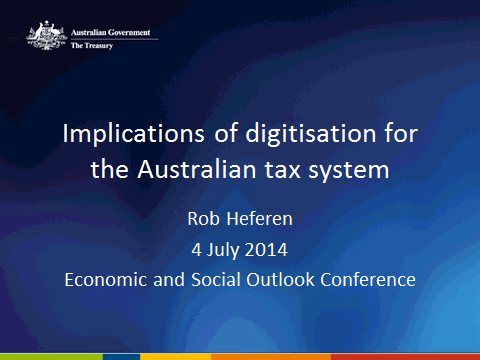
1. Introduction
Thank you for inviting me to speak today on the challenges for our tax system from the digital age.
In recent decades, digitisation has been a key contributor to increased productivity and greater globalisation. Globalisation has provided innovative businesses with tremendous success. Many that embraced its opportunities have been handsomely rewarded and those who resisted have fallen behind.
And this is no different with public policy, where successful thinkers are those who embrace change and challenge the state of play. Globalisation and digitisation have presented policy advisers and policy makers with opportunities to consider what constitutes an appropriate tax system in this ever changing world.
This issue is a high priority for the Government. As G20 President we have a key role in facilitating appropriate change at the heart of the G20’s tax agenda — one of the key focusses of the G20 in 2014 and 2015.
So today I would like to give my perspective on the opportunities that globalisation and the digital age have created, and in particular the implications for Australia’s corporate tax system and our tax system as a whole.
2. Corporate tax and tax avoidance in the digital economy
As I noted earlier, globalisation has been an overwhelmingly positive development. It has helped increase living standards by enabling businesses to increase their efficiency, to realise new opportunities and drive economic growth.
Export and import trade share
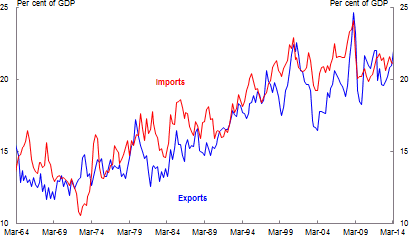
Source: ABS statistics
The chart shows the growth of Australian exports and imports over time. You can clearly see how Australia has benefitted from globalisation. Consumers have benefitted from the availability of a greater variety of goods, while Australian exporters have been able to take advantage from access to global markets.
And of course, digitisation has meant that new businesses and new ways of doing business have evolved and flourished. Today companies like Amazon, Apple, eBay, Facebook and Google are among the world’s most valuable companies with a combined market capitalisation of over USD 1.3 trillion1 — roughly the same as the top 200 companies in Australia2.
Top 500 listed US companies by sector
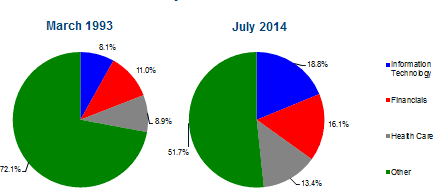
Source: Standard and Poor's
As you can see from this chart, the last 21 years has seen a huge change in the make-up of the largest 500 listed businesses in the US. The growth in the information technology sector has been pronounced while other service sectors like finance and health care have also grown quite strongly.
And as for which businesses and industries will boom tomorrow? I will leave that to your imagination.
As new businesses emerge and the global economy becomes more integrated, the economic landscape confronting policy-advisers changes.
This is perhaps most starkly seen in the area of corporate tax. International commerce has always posed difficulties for tax policy. We can have situations where investors reside in one country. Manufacturing takes place in another. Marketing and R&D goes on in a third country and consumption in a fourth. All four jurisdictions have a potential taxation claim. And this is where the problems of double taxation arise.
From the conclusion of the First World War where international trade was seen as an important driver to stimulate global growth, many countries, especially in Europe, became interested in dealing with double taxation problems.
In 1928, the League of Nations published the first internationally significant tax convention. The convention recognised the importance of sharing taxing powers between the source country and the residence country to prevent double taxation and promote cross-border activities.
Eliminating double taxation has never been more important than it is today.
International trade flows have increased dramatically over the last three decades. According to WTO trade statistics, the value of world merchandise exports rose from US$ 2 trillion in 1980 to US$ 18 trillion in 2011, which is equivalent to 7.3 per cent growth per year on average in current dollar terms3.
By and large, these rules have operated relatively well. But they have come under increasing pressure with the emergence of firms with complex, global value chains.
Add to this the increasing importance of intangibles to create economic value.
Corporate taxing rights stem ultimately from assumptions about where value is created and economic activity occurs. As the Prime Minister has said, the essential principle is that you should normally pay tax in the country where you’ve earned the profit. This has in truth never been straightforward, but in the digital world I am describing it has become increasingly contested.
Multinational enterprises now account for around 25% of world GDP. In "The Mirrlees Review: A US perspective" Alan Auerbach, one of the world’s leading taxation experts, cited this as one of the reasons why taxing corporations is complex. While he talks in the context of the US, for Australia I would say that the complexities are even more profound.
There are a range of conflicting objectives. Policy should support innovation and attract investment but also uphold tax integrity of the corporate tax system. It must take into account how other countries tax multinational enterprises as well as the wide range of successful tax planning strategies available.
We can see these difficulties in transfer pricing rules. When a firm ‘trades’ with itself across borders, there is always the potential for it to manipulate the prices that it charges for the exchange of goods and services internally.
The long standing solution to the problem is to use an arm’s length price to value related party transactions.
But this principle can be very difficult to enforce in practice. There are many goods including intangibles which are either proprietary or rarely traded, so there might not be a market price for the asset.
But in the modern economy, intangibles are of greater importance that ever. Think about some of today’s most valuable brands like Apple, Coca Cola, Google, McDonald’s and Microsoft – Forbes places a value of over US$ 104 billion on the Apple brand alone4.
While the arm’s length method, if able to be applied, can highlight some cases of profit shifting, the economics underlying it are not strong. For an economist, a firm can never be reduced to a series of arm’s length transactions. As Ronald Coase argued so compellingly in “The Theory of the Firm” in 1937, firms exist precisely because they create and capture value beyond what is obtainable through market based external contracts.
The difficulties in applying the arm’s length price is nothing new, but the nature of intangibles in the digital age makes it even harder and where the intangible in question is unique, it simply does not exist in the market. And by its very nature, intellectual property is always unique in some way.
This raises fundamental questions as to how enterprises in the digital age add value and make their profits, and how tax systems need to respond.
The notion of Base Erosion and Profit s
hifting or “BEPS”, has recently entered the public policy lexicon around the world. BEPS relates chiefly to instances where the interaction of different tax rules leads to double non-taxation or less than single taxation. It also relates to arrangements that achieve no or low taxation by shifting profits away from the jurisdictions where the activities creating those profits take place. It is squarely on the G20’s agenda and the OECD is well into a two-year work program in this area.
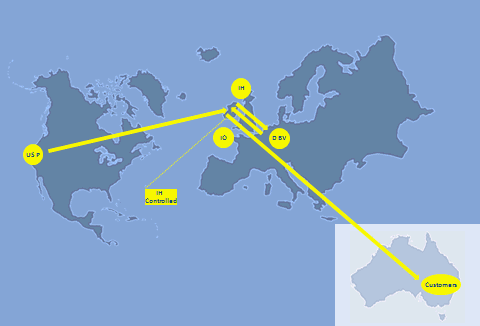
In recent years, intangibles have been the source of some very high profile and sophisticated tax planning techniques. These have significantly elevated concerns about BEPS. I’m sure many of you would have heard of one such technique that has come to worldwide attention called – the Double Irish Dutch Sandwich. A structure reportedly approved by the IRS.
The basic set up goes something like this. We have a US parent company whose employees developed, over many years, some intellectual property. Let’s say it’s the IP used to deliver internet advertising services. The Parent sells the rights to exploit the IP outside the United States, to its subsidiary company Ireland Holdings. Ireland Holdings is managed and controlled from another jurisdiction – say, Bermuda.
Ireland Holdings licences all the rights in the IP to a subsidiary company in the Netherlands – for a royalty fee. The Dutch company sub-licences the IP to Ireland Operations, who is the retailer of internet advertising.
Customers wishing to place ads enter into contracts with Ireland Operations on its website. This could be an Australian business wanting to advertise to its local customers.
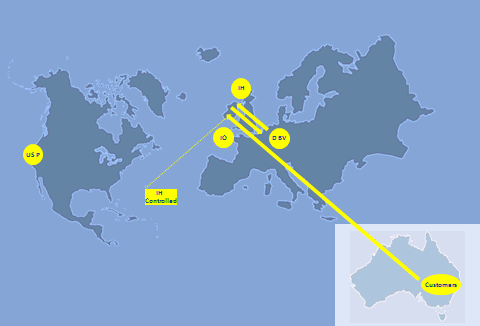
As a result of this complex arrangement, we ask, where is the tax paid?
The cost of advertising for the customer is reported as income in Ireland Operations. Its taxable income is substantially reduced by the tax deduction it receives on the royalty payment to Dutch Holdings. Under EU law, withholding tax can’t be applied to the royalty payment from Ireland to the Netherlands.
Similarly, the Dutch subsidiary pays a small amount of corporate tax on the difference between royalties received and paid, with no withholding tax on the payment of royalties.
You would think that the royalty payment received by Ireland Holdings would be taxed in that country, but it is not. This is because of the interaction between Ireland’s residency rules, Bermuda’s tax haven status and the US’ check-the-box rules.
Maybe there was some tax paid in the US when the IP was originally transferred to Ireland. And if the IP was appropriately valued at that time, then we might not be so concerned about the arrangement. But, as we discussed earlier, it is difficult for tax authorities to value the IP in related party transactions.
But let’s focus on Australia now. Under this arrangement, the profit on sale of advertising into Australia is not taxable in Australia. But should it be?
Some of questions that run through my head include, is the sale of the advertising, in substance, really a service provided by Ireland to Australia. Does it really look like an import? The complex nature of this structure gives the impression that it is artificial; and more generally it doesn’t pass the sniff test.
Are genuine activities and value-add services conducted in Australia? If so, then conceptually some of the profit should be taxed in Australia and current law says it should.
Let me pose you this question, what if the transaction involved a tangible business input such as a tractor? What if an Australian farmer bought a tractor from a manufacturer in Ireland and the tractor maker had no presence in Australia. Should the profits from the sale of the tractor be taxed in Australia? I think the answer is clearly no.
3. Broader implications of digitisation for corporate tax
What this highlights is that, while national and international efforts will take us some way to addressing BEPS, the increasing importance of intangibles means we are dealing with major changes in our economy that require a fundamental rethink of our tax policy.
Globalisation has enabled the free movement of capital and labour – shifting manufacturing bases from high-cost to low-cost locations, gradual removal of trade barriers and the development of technology and telecommunications. These changes have significantly altered the way cross-border activities take place.
For tangible goods, it is easy to establish the location of production and therefore where the profit is earned and company tax has to be paid. The facts in this case are clear – we can fix where, geographically, the tractor is made.
For intangibles, however, the facts are not clear. Just where, you might well ask, is the economic activity generating the profit occurring? In Australia, in Ireland, in the US or nowhere in particular?
While a lot of the attention is focused on Double Irish Dutch Sandwiches and other complex tax arrangements, the issue for Australia as the consumer remains essentially the same – do we have a taxing right over the income?
And in situations where there is some activity taking place in Australia, how much value should be attributed to the operations in Australia? Which is where our permanent establishment and transfer pricing rules come into play. This is an area where the BEPS work might help.
And this presents interesting questions for policy advisers; whose tax base has been eroded? Which country has missed out on the tax revenue? In the case of the tractor, Australia – as the location of consumption — has no corporate taxing right. The erosion of our corporate tax base in this example – the switch from domestically-sourced to imported goods – is simply a by-product of international trade.
Should the intangible be any different?
Two big issues arise. The first is that the corporate tax matters a lot for Australia.
The second is that if Australian taxpayers feel the system is not fair it erodes voluntary compliance. And for Australia this could be a big deal.
Our system relies on high levels of voluntary compliance. Around 95% of revenue collected comes from those who lodge and pay on time; the balance as a result of the Australian Taxation Office’s active compliance efforts5.
Our high level of willing participation in Australia is the result of many factors – such as belief in taxes, trust in the fairness of our system and the integrity of the administration.
It is critical to ensure that this confidence remains and if multinational enterprises are using elaborate tax structures to artificially separate taxable income from the activities then this might lead to the perception that a fair share of tax isn’t being paid that is, that the shareholders of the multinational aren’t making an appropriate contribution to Australia’s coffers. Ultimately, this could lead to a bigger risk that other taxpayers stop complying and thereby erode Australia’s tax base.
4. Tax design and reform
So the looming question is what should we do?
Traditionally, we have managed risks by running a pretty tight ship when it comes to integrity measures.
Australia has a comprehensive CFC regime, tough transfer pricing rules and extensive general anti-avoidance rules.
And in the wake of clever tax planning by some multinationals, the government has been quick to further respond.
In view of evidence of multinational enterprises claiming excessive debt deductions in Australia, the government last year com
mitted to reducing the thin capitalisation safe harbour to deal with this sort of planning. The Government will also ensure multinational taxpayers can no longer claim a tax exemption for interest income from loans to offshore subsidiaries, where this income should be assessable. I note that this tightening was announced by the previous Government in the 13-14 Budget and committed to by the current Government in November 2013. Although some recent press reports suggest that not all commentators are following these developments as closely as they ought.
But this is probably the sensible limit of integrity measures.
In particular, we need to recognise further changes come at a cost, through increased complexity and compliance costs. And the complexity and costs can be expected to rise as the pressure increases.
Increased reliance on company tax
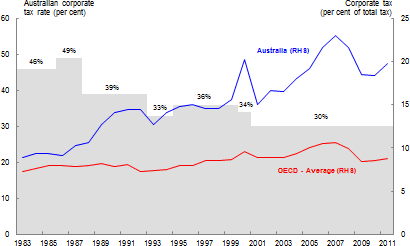
Source: OECD
I noted earlier that corporate tax matters for Australia.
This chart shows that despite decisions that have lowered corporate tax rates across the decades, our reliance on corporate tax has generally increased.
From 1983 to 2011, the OECD average corporate tax revenue as percentage of total taxation has remained relatively stable around 8.5% (the red line). This is in contrast to Australia where over the same period, the reliance on the corporate tax base increased from 9% to almost 20% (the blue line).
This reflects, in part, classification differences in disaggregating company income taxes and Australia's abundance of natural resources, a high level of incorporation, our dividend imputation system, and a relatively broad company income tax base6.
Notwithstanding this, high rate of corporate tax will always leave us vulnerable to profit-shifting.
The OECD suggests there would be economic benefits if countries consider a tax mix which encourages more stable bases.
This is no easy challenge. The last set of corporate tax rate reductions were funded through extensive broadening of the company tax base. It’s now about as broad as it can get.
So can this rate come down? What are our options?
We will also need to tackle another, even bigger challenge, on the personal tax side.
Tax structure
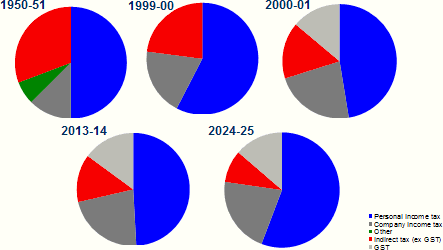
Source: RBA statistics, Budget 2014-15 and Treasury estimates
As this chart shows, if we were to leave our tax rates and bases as they are, our reliance on income taxes will grow over time.
We will move even further in this direction if, as we anticipate, the relative share of total indirect taxes including the GST continues its long-term decline. At the same time fiscal drag, or bracket creep will mean our reliance on personal income tax will grow to levels well beyond levels we have become accustomed to.
Personal income tax rates and the effects of fiscal drag
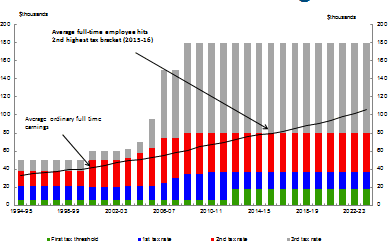
Note: Based on Budget 2014-15 parameters
This will potentially push those on AWOTE into the 39% bracket by 2015. So the question on how and when to return bracket creep will be important.
And finally, we will also face the challenge of balancing these tax reform objectives against our growing budget pressures.
5. Conclusion
As I mentioned at the start, globalisation and digitisation has presented us with many opportunities; improving living standards. But it also places pressure on our corporate tax system. Of course, we are not alone in this; countries around the world are confronting the same issue.
As G20 President in 2014, Australia is driving the G20's commitment to a global response to BEPS based on sound tax policy principles.
But the challenges for the corporate tax base are not going away — they are growing. Globalisation, increased importance of intangibles and our high reliance on corporate tax are challenges we know about. No doubt there are others. We need to aspire to a tax system that is robust, and flexible enough to adapt to these changes.
How should we respond? As a policy adviser, but not a policy maker it could, of course, be presumptuous of me to proffer a view. Needless to say the Tax White Paper provides an exciting opportunity to take a big step forward in addressing this challenge. And it’s a key challenge in the content of ensuring our future prosperity.
1 Nasdaq, viewed 1 July 2014; Market Watch, The Wall Street Journal, viewed 1 July 2014
2 S&P Dow Jones Indices, S&P/ASX200, viewed 1 July 2014
3 World Trade Organization: World Trade Report 2013; Factors shaping the future of world trade, Geneva, Switzerland.
4 Forbes, The World’s Most Valuable Brands (November 2013), viewed on 1 July 2014
5 Jordan, C, Commissioner of Taxation, Keynote address to the Institute of Chartered Accountants Australia (ICAA) Practice Forum, Sydney, Thursday, 12 June 2014
6 The Treasury 2010, Australia's future tax system, Report to the Treasurer, Canberra.